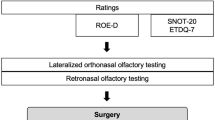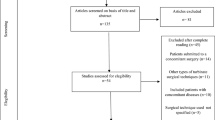Abstract
Background
Following rhinoplasty, the cross-sectional parts of the nose may be significantly reduced, and nasal air movement and olfaction may be altered. Studies on olfactory function after surgical procedures are quite limited and have largely focused on sinus surgery or septoplasty.
Objectives
The objective of this study is to assess the consequences of spreader grafts on olfactory function.
Methods
This prospective study was conducted at the Gaziosmanpaşa Taksim Education and Research Hospital, Department of Otolaryngology, from January 2014 to June 2015. In total, 68 patients who had undergone an open-technique septorhinoplasty were included. In 35 patients, bilateral spreader grafts were included with the open septorhinoplasty (group 1), and 33 patients underwent open septorhinoplasties without spreader grafts (group 2).
Results
The age and gender distributions of the patients in the two groups did not differ (p > 0.05). Preoperative threshold, discrimination, and identification values in both groups did not differ (p > 0.05). In groups 1 and 2, postoperative threshold values were significantly higher than preoperative values (p < 0.05). The change in threshold, discrimination, and identification level was significantly higher postoperatively versus preoperatively in group 1 (p < 0.05); however, the changes in discrimination and identification values did not significantly differ between in group 2 (p > 0.05).
Conclusions
Our study demonstrates the superior widening effect of spreader grafts over the nasal valve and favorable results in olfactory function in primary septorhinoplasty patients.
Level of Evidence IV
This journal requires that the authors assign a level of evidence to each article. For a full description of these Evidence-Based Medicine ratings, please refer to the Table of Contents or the online Instructions to Authors www.springer.com/00266.




Similar content being viewed by others
References
Zhao K, Scherer PW, Hajiloo SA, Dalton P (2004) Effect of anatomy on human nasal air flow and odorant transport patterns: implications for olfaction. Chem Senses 29:365–379. doi:10.1093/chemse/bjh033
Pade J, Hummel T (2008) Olfactory function following nasal surgery. Laryngoscope 118:1260–1264. doi:10.1097/MLG.0b013e318170b5cb
Briner HR, Simmen D, Jones N (2003) Impaired sense of smell in patients with nasal surgery. Clin Otolaryngol Allied Sci 28:417–419. doi:10.1046/j.1365-2273.2003.00735.x
Tekeli H, Altundağ A, Salihoğlu M et al (2013) The applicability of the “Sniffin’ Sticks” olfactory test in a Turkish population. Med Sci Monit 19:1221–1226. doi:10.12659/MSM.889838
Pfaar O, Hüttenbrink KB, Hummel T (2004) Assessment of olfactory function after septoplasty: a longitudinal study. Rhinology 42:195–199
Kovacevic M, Wurm J (2015) Spreader flaps for middle vault contour and stabilization. Facial Plast Surg Clin N Am 23:1–9. doi:10.1016/j.fsc.2014.09.001
Ozturan O (2000) Techniques for the improvement of the internal nasal valve in functional-cosmetic nasal surgery. Acta Otolaryngol 120:312–315. doi:10.1080/000164800750001152
Philpott CM, Rimal D, Tassone P et al (2008) A study of olfactory testing in patients with rhinological pathology in the ENT clinic. Rhinology 46:34–39
Poirrier AL, Ahluwalia S, Goodson A et al (2013) Is the Sino-Nasal Outcome Test-22 a suitable evaluation for septorhinoplasty? Laryngoscope 123:76–81. doi:10.1002/lary.23615
Niechajev I (2015) Comparison of various rhinoplasty techniques and long-term results. Aesthet Plast Surg. doi:10.1007/s00266-015-0506-8
Schriever VA, Gupta N, Pade J et al (2013) Olfactory function following nasal surgery: a 1-year follow-up. Eur Arch Otorhinolaryngol 270:107–111. doi:10.1007/s00405-012-1972-0
Erdogan M, Cingi C, Seren E et al (2013) Evaluation of nasal airway alterations associated with septorhinoplasty by both objective and subjective methods. Eur Arch Otorhinolaryngol 270:99–106. doi:10.1007/s00405-012-1974-y
Sheen JH (1984) Spreader graft: a method of reconstructing the roof of the middle nasal vault following rhinoplasty. Plast Reconstr Surg 73:230–239
Delank KW, Stoll W (1994) Sense of smell before and after endonasal surgery in chronic sinusitis with polyps. HNO 42:619–623
Dürr J, Lindemann J, Keck T (2002) Sense of smell before and after functional esthetic rhinoplasty. HNO 50:626–629
Grymer LF (1995) Reduction rhinoplasty and nasal patency: change in the cross-sectional area of the nose evaluated by acoustic rhinometry. Laryngoscope 105:429–431. doi:10.1016/0278-2391(95)90649-5
Teymoortash A, Fasunla JA, Sazgar AA (2012) The value of spreader grafts in rhinoplasty: a critical review. Eur Arch Otorhinolaryngol 269:1411–1416. doi:10.1007/s00405-011-1837-y
De Pochat VD, Alonso N, Mendes RRS et al (2012) Nasal patency after open rhinoplasty with spreader grafts. J Plast Reconstr Aesthet Surg 65:732–738. doi:10.1016/j.bjps.2011.11.059
Görgülü T, Özer CM, Kargi E (2015) The accordion suture technique: a modified rhinoplasty spreader flap. J Craniomaxillofac Surg. doi:10.1016/j.jcms.2015.03.036
Basaran K, Basat SOSFA (2015) An easy spreader graft fixation technique by using a modified speculum in rhinoplasty. J Craniofac Surg 26:363–372
Eren SB, Tugrul S, Ozucer B et al (2014) Autospreading spring flap technique for reconstruction of the middle vault. Aesthet Plast Surg. doi:10.1007/s00266-014-0292-8
Acartürk S, Gencel E (2003) The spreader-splay graft combination: a treatment approach for the osseocartilaginous vault deformities following rhinoplasty. Aesthet Plast Surg 27:275–280. doi:10.1007/s00266-003-3030-1
Abbou R, Bruant-Rodier C, Wilk A et al (2014) Open rhinoplasty: influence of incisions, alar resection, and columellar strut on final appearance of the tip. Aesthet Plast Surg 38:1077–1082. doi:10.1007/s00266-014-0395-2
Saleh AM, Younes A, Friedman O (2012) Cosmetics and function: quality-of-life changes after rhinoplasty surgery. Laryngoscope 122:254–259. doi:10.1002/lary.22390
Szychta P, Rykała J, Kruk-Jeromin J (2011) Individual and ethnic aspects of preoperative planning for posttraumatic rhinoplasty. Eur J Plast Surg 34:245–249. doi:10.1007/s00238-010-0502-9
Stewart MG, Witsell DL, Smith TL et al (2004) Development and validation of the nasal obstruction symptom evaluation (NOSE) scale. Otolaryngology 130:157–163. doi:10.1016/j.otohns.2003.09.016
Afifi AM, Kempton SJ, Gordon CR et al (2015) Evaluating current functional airway surgery during rhinoplasty: a survey of the american society of plastic surgeons. Aesthet Plast Surg 39:181–190. doi:10.1007/s00266-015-0449-0
Mohammadshahi M, Pourreza A, Orojlo PH et al (2014) Rhinoplasty as a medicalized phenomenon: a 25-center survey on quality of life before and after cosmetic rhinoplasty. Aesthet Plast Surg. doi:10.1007/s00266-014-0323-5
Fatemi MJ, Rajabi F, Moosavi SJ, Soltani M (2012) Quality of life among Iranian adults before and after rhinoplasty. Aesthet Plast Surg 36:448–452. doi:10.1007/s00266-011-9820-y
Lipan MJ, Most SP (2014) Development of a severity classification system for subjective nasal obstruction. JAMA Facial Plast Surg 15:358–361. doi:10.1001/jamafacial.2013.344
Damm M, Vent J, Schmidt M et al (2002) Intranasal volume and olfactory function. Chem Senses 27:831–839. doi:10.1093/chemse/27.9.831
Damm M, Eckel HE, Jungeholsing M, Hummel T (2003) Olfactory changes at threshold and suprathreshold levels following septoplasty with partial inferior turbinectomy. Ann Otol Rhinol Laryngol 112:91–97
Minovi A, Hummel T, Ural A et al (2008) Predictors of the outcome of nasal surgery in terms of olfactory function. Eur Arch Otorhinolaryngol 265:57–61. doi:10.1007/s00405-007-0409-7
Author information
Authors and Affiliations
Corresponding author
Ethics declarations
Conflict of Interest
The authors declare that they have no conflicts of interest to disclose.
Rights and permissions
About this article
Cite this article
Ulusoy, S., Dinç, M.E., Dalğıç, A. et al. Effects of Spreader Grafts on Olfactory Function in Septorhinoplasty. Aesth Plast Surg 40, 106–113 (2016). https://doi.org/10.1007/s00266-015-0597-2
Received:
Accepted:
Published:
Issue Date:
DOI: https://doi.org/10.1007/s00266-015-0597-2




